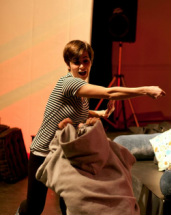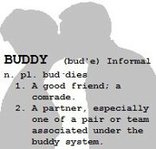 From BURNING UP THE DICTIONARY
From BURNING UP THE DICTIONARY
 From BURNING UP THE DICTIONARY From BURNING UP THE DICTIONARY Like any other design discipline, fight directing begins with the text. I'd like to take a moment to discuss approaching a text as a fight director and/or a movement specialist. While it's obvious that the play must be read before any other work is done, what one is looking for when they read and how one's findings are utilized hasn't had a whole lot of public discussion.
0 Comments
 Graphic by Alison McDonough Last month I had the pleasure of having a public staged reading of my new full-length play, Burning Up the Dictionary, performed with Vagabond Theatre Group. This took place at Trident Booksellers & Cafe as part of their "There Will Be Words" reading series. Before I say much more I do have to point out that I was very amused to have a play that's largely about language appear in a series called "There Will Be Words." Readings are a step in the development of a new play. I once discussed this process with a computer programmer friend and we realized that we had something significant in common: neither playwrights nor programers really know what they've done until they get to see it running. The staged reading is a sort of a test run of a play wherein the writer can figure out what changes they intend to make as the work evolves. This was the first time I've heard the play in its entirety in front of an audience. I did have the privilege of a table reading of an earlier full draft at the Lark Play Development Center this past November (which I blogged about here) and I got to hear a chunk of it at a Small Theatre Alliance reading back in September (which I also blogged about) after earlier development through Playwrights' Commons' Summer Playground. All three were really useful experiences, and the script has come a long way because of them, but this last piece was a larger step as it was an opportunity for me to evaluate the current (more advanced) draft under more public conditions and figure out what to do with it next. In the past few days I've had three major projects come to fruition: my round table of Burning Up the Dictionary at the Lark Play Development Center, my devised piece, Ghosts of Hamlet in Something Rotten: Hamlet Remixed at the Boston Center for the Arts, and my talk as an alumni speaker at TEX: Tufts Idea Exchange. In the middle of all of this, I did the fights for The Nutcracker at Stoneham Theatre and continued my work on The Miracle Worker at Salve Regina University.
TEX will most likely get its own blog post some time after the videos are posted online. So I'd like to discuss the new plays, Burning Up the Dictionary and Ghosts of Hamlet. One piece is a fairly straightforward full length play, the other is a short piece of devised experimental theatre. Let's start with the less conventional of the two: Words in the theatre are but a design on the canvas of motion. - V. Meyerhold
This is the graphic for a little something I have in the works with Whistler in the Dark Theatre and Imaginary Beasts as part of the Double, Double Toil and Trouble: A Witches Brew of Shakespeare Remixed series that's coming up (this is in addition to my participation as fight director of Dogg's Hamlet, Cahoot's Macbeth, which has been a great time so far). I am creating a piece as part of this: |
Taking Note & Taking Notes
Meron Langsner, PhD
Playwright, Theatre & Performance Scholar, Fight Director/Movement Specialist, Director, Educator Archives
June 2020
Categories
All
|
 RSS Feed
RSS Feed